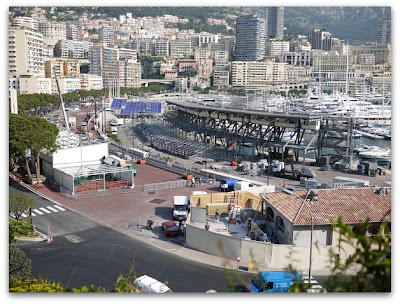It's that time of year again and everywhere in Monaco things are springing up seemingly out of nowhere.
No, I don't mean fragrant spring flowers, little chicks peeping from eggs and a gentle warmth to the air, I mean scaffolding, chain link fence, barricades and noisy paving machines!
 |
| An Ominous Sign |
It starts slowly and creeps up on you like a head cold. First come the barricades and the plentiful "No Parking" signs sprinkled everywhere. Then come the paving trucks and then it dawns on you. Uh oh. A quick peek at the calendar and dread sets in. Yikes, it's that time of year again! The Monaco Grand Prix!
Since 1929, thanks to the Automobile Club of Monaco (ACM for short) the Principality transforms from a lovely and pretty village to an ugly Formula 1 racetrack. As you can guess by my tone, I'm not a fan of the Grand Prix even though Uncle Jim really enjoys it.
I can definitely say that I'm not alone. The construction of the racetrack makes it difficult and sometimes impossible to navigate the normally pleasant streets. Even a simple outing can become an exercise in patience, perseverance and agility.
Just last week I helped a woman in tears trying to push her baby carriage around the port where the racing pits were being set up. What should have been a pleasant afternoon stroll with her baby became a nightmare. We struggled together to lift the pram, baby and all over a metre high barricade because the builders had not made any provision for pedestrians let alone for anyone pushing a baby carriage.
And then there are those fun seekers who seize the moment only to have it all end in tears: a few years back in the middle of the night, some daring dodo went roaring through the circuit's only tunnel at 100 km/h, double the normal speed limit but only about one third of the speed at which the skilled F1 drivers zoom through.
Predictably, he crashed, even though ironically, the tunnel is one of the few places during the race where the F1 drivers can floor it. Luckily he survived. His Ferrari didn't.
Seventy-eight times around the circuit the brave and daring drivers zoom, sometimes reaching speeds of up to 280 km/h. What isn't evident from looking at a map of the circuit is that it's not flat - as it winds through Monaco it climbs and descends hills along hairpin curves making it the most challenging and dangerous of all the F1 circuits. I guess this explains why it's so popular.
 |
| Week One |
Even though creating the circuit and preparing for the race is annoying for those of us who live here, I truly appreciate what an engineering and logistics miracle it is.
During a span of a few weeks, like tireless ants and nimble monkeys, 100 or so skilled workers construct seating for 22,000 people, erect safety barricades that line the entire length of the 3.34 km circuit and install literally thousands of tons of safety features.
 |
| Week Two |
The volume of equipment they need is mind boggling: 18,680 km in length of crash barriers, 6 km of 2.5 metre high chain link fencing, 28.7 km of cabling on top of 1,700 posts, and just for added measure, 6,750 rubber tires so cars can bounce instead of crumple if they crash.
 |
| Week Three |
Mr Maamar Farhi, the man in charge of setting up the circuit said in a recent interview with the local newspaper, Nice Matin, that it's a challenge because the set up is done amidst busy streets and sidewalks with cars and people circulating about. He should know. He's been doing it for 35 years.
If you'd like to see the race you're better off watching from the comfort of your own living room unless you can afford the hotels and restaurants who unfairly inflate their prices to make the most of the increased demand. If this doesn't deter you then go for it - you can expect to shell out $2,200 for a prime seat near the pits or if you happen to have a good set of binoculars and don't mind standing on a hillside surrounded by weeds, $63. Add $6 for ear plugs.
No doubt about it, The Grand Prix is a huge money-maker for Monaco. Tens of thousands of visitors arrive to the tune of millions of dollars injected into the local economy each year.
Here’s a fun fact: if you're in Monaco when it's not set up like a race track and you want to know where it runs just look down. Permanently installed in the pavement that lines both sides of the circuit are rectangular plates, each about 20 by 10 cms. Pop off the plate and you'll find a hollow metal cylinder in which the set up crews insert metal tubing to mount the framework for posts and barricades. After the race, it all comes down, even faster than it went up and things return to normal.
Between races, all of the equipment is stored in a giant warehouse in France until the whole thing starts over again next year.
As for me, I'll be fleeing the craziness as I do every year. You'll find me in Canada watching the race on TV with my dad, from the comfort of our living room with a mute button and a plate of cookies, trying to spot Uncle Jim in the crowd. I must confess though, seeing Monaco on TV from that far away does make me a little homesick....









No comments:
Post a Comment
Come on, tell Auntie what's on your mind...